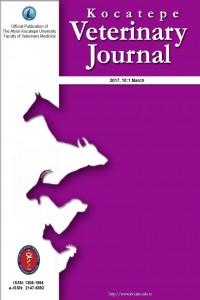Abstract
Sunulan makalede dişlerde renk değişimi ile karakterize ilginç bir vaka tanımlandı. Olgu materyalini rutin aşılama için kliniğe getirilen 3.5 yaşlı dişi köpek oluşturdu. Alınan anamnezde hastada egzersiz intoleransı, aralıklı öksürük ve nefes darlığı olduğu belirlendi. Hasta; tam kan sayımı, serum biyokimya ölçümleri, akciğer grafisi ve detaylı fizik muayene ile değerlendirilmiştir. Hızlı tanı test kiti (SNAP 4DX) analiz sonuçları, köpeğin Drofilaria immitis ile enfekte olduğunu ortaya koydu. Hastanın ağız boşluğu muayenesi sırasında, olağan dışı bir bulgu olarak, dişlerde pembemsi renk değişikliği tespit edildi (Şekil 1). Elde edilen bulgular aşağıda tartışılmıştır.
Keywords
References
- Allione A, Bernabei P, Bosticardo M, Ariotti S, ForniG, and Novelli F. Nitricoxidesuppresseshuman T lymphocyteproliferationthrough IFN--dependentand IFN--independentinduction of apoptosis. J. Immunol. 163:4182–4191. 1999.
- Bandi C, Dunn AM, Hurst GD and Rigaud, T Inherited microorganisms, sex-specific virulence and reproductive parasitism. Trends Parasitol. 17. 88–94, 2001.
- Casiraghi M, McCall JW, Simoncini L, Kramer LH, Sacchi L, Genchi C, Werren JH and Bandi C. Tetracycline treatment and sex-ratio distortion: a role for Wolbachia in the moulting of filarial nematodes. Int. J. Parasitol. 32, 1457–1468, 2002.
- Brattig NW, Büttner DW, Hoerauf A. Neutrophil accumulation around Onchocerca worms and chemotaxis of neutrophils are dependent on Wolbachia endobacteria. Microbes Infect. 3, 439–446, 2001.
- Taylor-Robinson AW, Liew FY, Severn A, Xu DM, McSorley SJ, Garside P, Padron J, and Phillips RS Regulation of the immune responseby nitricoxide differentially producedby T hepler type 1 and T hepler type 2 cells. Eur. J. Immunol. 24:980–984, 1994.
- Bogdan C. Nitricoxide and the immuneresponse. Nat. Immunol. 2:907–916, 2001.
- Dai WJ and Gottstein B Nitricoxide mediatedimmuno suppression following murine Echinococcus multilocularisin fection. Immunology 97:107–116, 1999.
- Atochina O, Daly-Engel T, Piskorska McGuire DE and Harn DA. A schistosome-expressed immunomodulatory glycoconjugate expands peritoneal Gr1 macrophages that suppressnaive CD4 T cell proliferation via an IFN—and nitricoxide-dependent mechanism. J. Immunol. 167:4293– 4302, 2001.
- O'Connor RA, JS Jenson and Devaney E. NO contributes to proliferative suppression in a murine model of filariasis. Infect. Immun. 68:6101-6107, 2000.
- Oliveira DM, Gustavson S, Silva-Teixeira DN and Goes A M. Nitric oxide and IL-10 production induced by PIII—a fraction of Schistosoma mansoni adult worm antigenic preparation—associated with downregulation of in vitro granuloma formation. Hum. Immunol. 60:305-311, 1999.
- Hiroyuki T, Shinjiro I, Setsuko T, and Koichiro F. Dirofilaria immitis PolyproteinUp-Regulates Nitric Oxide Production . Infectıon and Immunıty, 9: 5283–5286, 2002.
Abstract
In the presented article, an interesting case was defined by the color change in the teeth. The case material consisted of 3.5 old female dogs was refered to the clinic for routine vaccination. In our study, it was determined that the patient had exercise intolerance, intermittent cough and shortness of breath. Patient; Complete blood count, serum biochemistry measurements, chest X-ray and detailed physical examination. The results of the rapid diagnostic test kit (SNAP 4DX) analysis revealed that the dog was infected with Drofilaria immitis. During the patient's oral cavity examination, a pinkish color change was detected in the teeth as an unusual finding (Figure 1). The findings are discussed below.
Keywords
References
- Allione A, Bernabei P, Bosticardo M, Ariotti S, ForniG, and Novelli F. Nitricoxidesuppresseshuman T lymphocyteproliferationthrough IFN--dependentand IFN--independentinduction of apoptosis. J. Immunol. 163:4182–4191. 1999.
- Bandi C, Dunn AM, Hurst GD and Rigaud, T Inherited microorganisms, sex-specific virulence and reproductive parasitism. Trends Parasitol. 17. 88–94, 2001.
- Casiraghi M, McCall JW, Simoncini L, Kramer LH, Sacchi L, Genchi C, Werren JH and Bandi C. Tetracycline treatment and sex-ratio distortion: a role for Wolbachia in the moulting of filarial nematodes. Int. J. Parasitol. 32, 1457–1468, 2002.
- Brattig NW, Büttner DW, Hoerauf A. Neutrophil accumulation around Onchocerca worms and chemotaxis of neutrophils are dependent on Wolbachia endobacteria. Microbes Infect. 3, 439–446, 2001.
- Taylor-Robinson AW, Liew FY, Severn A, Xu DM, McSorley SJ, Garside P, Padron J, and Phillips RS Regulation of the immune responseby nitricoxide differentially producedby T hepler type 1 and T hepler type 2 cells. Eur. J. Immunol. 24:980–984, 1994.
- Bogdan C. Nitricoxide and the immuneresponse. Nat. Immunol. 2:907–916, 2001.
- Dai WJ and Gottstein B Nitricoxide mediatedimmuno suppression following murine Echinococcus multilocularisin fection. Immunology 97:107–116, 1999.
- Atochina O, Daly-Engel T, Piskorska McGuire DE and Harn DA. A schistosome-expressed immunomodulatory glycoconjugate expands peritoneal Gr1 macrophages that suppressnaive CD4 T cell proliferation via an IFN—and nitricoxide-dependent mechanism. J. Immunol. 167:4293– 4302, 2001.
- O'Connor RA, JS Jenson and Devaney E. NO contributes to proliferative suppression in a murine model of filariasis. Infect. Immun. 68:6101-6107, 2000.
- Oliveira DM, Gustavson S, Silva-Teixeira DN and Goes A M. Nitric oxide and IL-10 production induced by PIII—a fraction of Schistosoma mansoni adult worm antigenic preparation—associated with downregulation of in vitro granuloma formation. Hum. Immunol. 60:305-311, 1999.
- Hiroyuki T, Shinjiro I, Setsuko T, and Koichiro F. Dirofilaria immitis PolyproteinUp-Regulates Nitric Oxide Production . Infectıon and Immunıty, 9: 5283–5286, 2002.
Details
| Journal Section | LETTER TO THE EDITOR |
|---|---|
| Authors | |
| Publication Date | March 1, 2017 |
| Acceptance Date | February 1, 2017 |
| Published in Issue | Year 2017 Volume: 10 Issue: 1 |
Cite

